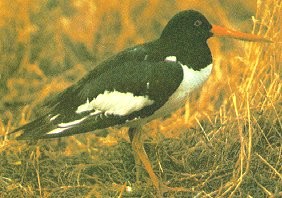 Synonyms:
None.
Synonyms:
None.Haematopus ostralegus (Linnaeus, 1758)
 Synonyms:
None.
Synonyms:
None.
Common names: Bulg: Stridoyad; Engl: Oystercatcher; Rom: Scoicar; Russ: Kulik-soroka; Turk: Poyraz kusu; Ukr: Kulyk-soroka.
Order (Scientific): CHARADRIIFORMES.
Family (Scientific): HAEMATOPODIDAE.
Taxonomic descriptions: Haematopus ostralegus is one of 4 (from other sources 7-8) species of genus Haematopus (Linnaeus, 1758). The Black Sea region is populated by nominative sub-species - H. o. ostralegus. The Azov-Black Sea population is subjected to annual fluctuations related to weather conditions during the year. Its size is estimated to be between 250 and 400 pairs.
 IUCN Status:
IUCN Status:
World level: VU
Black Sea Regional level: VU
Subregion level: VU
Distribution:
Habitats type, Critical habitats, Limiting factors: Breeding habitats are sandy sites on the islands, spits and big rivers, sea coast and estuaries. The species was recorded breeding in agricultural lands (bare fallow, degraded fallow, perennial herbs) in recent years. Broods and feeding birds occur exclusively in shallow areas and on the water-line.
Biology: Breeding, and usually migratory species. Arrival depends on the weather conditions and has been recorded from late February till late March. Breeding begins in mid April. The nest, a small deepening in the ground, almost without any bedding. The clutch consists of three eggs. Chicks hatch from the end of May till the beginning of June, fledglings occur from late June. Autumn migration is prolonged from August and lingers till early October. As a rule, Haematopus ostralegus prey upon small molluscs and copepods along the shore-line. Large invertebrates comprise their basic food in the agricultural lands.
Population trends: A slight decrease has been recorded, though in some sub-regions the numbers have remained stable during the last two decades.
Threats: Low breeding numbers and the vulnerability of the habitats pose a clear risk for the Black Sea Haematopus ostralegus population. Recreation development, the dynamics of the accumulative formations, sand extraction at the sea-side and in the estuaries, constant human disturbance and predation may destroy the relative population stability in the very near future.
Conservation measures taken: Creation of the Sivash and Azov Sea National Parks System, which will greatly contribute to species protection in the region.
Conservation measures proposed: None.
References:
Compiled by: J.Chernichko.